Posts Tagged Religion & Spirituality
Who are Gilgamesh and Enkidu
Posted by Kim Graae Munch in Esoterics, Rosicrucianism on June 4, 2010
Who are Gilgamesh and Enkidu
There are at least two levels or stories in this epos. There are the story about two human beings and their endeavors, and there is the story about mankind, where Enkidu symbolizes the sentient soul and Gilgamesh the Mind soul, the Ego.
On the personal plane we learn through Enkidu the descent into the physical plane and through Gilgamesh the ascent up from the physical plane.
I will here try to find the deeper aspects of these beings in the esoteric history of man, looking at them as persons and as symbols. The first part will mainly build on Rudolf Steiner’s “Occult History” lectures 1 and 2, concentrating on the persons of Gilgamesh and Enkidu, or Eabani as Steiner calls him. In the second part I will look at the events on the spiritual plane to show their symbolic nature.
From Occult History by Rudolf Steiner
In Occult History Rudolf Steiner tells:
These beings are the highest developed persons within the human wave, and already on the old Moon were they selected for their part in the development of Earth. We know them as the twelve Bodhisattvas, the seven Sages, and as Christian Saints.
In the start of the second lecture RS elaborates on this theme:
This is the definition of the Bodhisattvas and their helpers, who are guiding the human history through the recurring crises caused by the powers of resistance.
The Gilgamesh epic is a remarkable myth, describing the esoteric path as it is until our time and written as it was written for us.
The myth describes the development until the initiation, which first became possible later.
Who are Gilgamesh?
As the previous quote says, Gilgamesh is a being with enormous potential.
Now Gilgamish was a personality who had many incarnations behind him and may therefore be called an “old” soul within the evolution of humanity…The souls who came down early have therefore more incarnations behind them in earth-evolution than those who came down later; hence we can call these latter, in contrast to the former, “younger” souls — souls who have taken less into themselves…
In the case of Gilgamish, the Being who was to reveal himself through him, and who could do so only by leading him presently to a kind of initiation, kept a guiding hand upon him from the outset and set him at the place where he came to recognise his own position in the history of the world…
The whole nature of an old soul will enable it early in life to grasp not only the essential element, the essential factor, in the existing culture, but also that which strikes into it as a new impulse, opening up a wide vista into the future. [2]
Gilgamesh incarnated back in Lemuria, maybe as the first of the development wave of man. Through his many incarnation he had reached a stage about where man were at the time of the Maid of Orleans. 2 This is one of the reasons why RS uses the word personality about him, he has developed the Ego as no other person have at this time in history, he have lost all connections to the spiritual world, and is as Ahrimanic as a man can be, as the son of Adam, Cain. His task is to form the development of the Earth, he is the archetypal Hero.
It could be understood as nephesch (sentient soul) and ruach (mind soul) are full developed, but that n’schamah (consciousness soul) is not, two out of three.
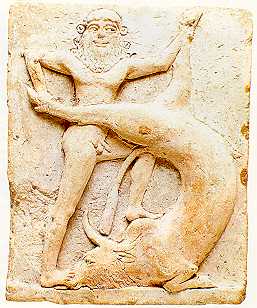 Gilgamesh – The Archetypal Hero
Gilgamesh – The Archetypal Hero
Who are Enkidu?
Enkidu (Eabani) is a diametrical different being; Enkidu is a being with few incarnation, ego-less and without karma, he lives in innocence with the animals. Through Enkidu’s encounter with a woman he acquires karma and becomes part of humanity, becomes part of civilization.
…
Eabani is depicted as being clothed in skins of animals. This is an indication of his wild nature; but because of this very wildness he is still endowed with ancient clairvoyance an the one hand, and an the other hand he is a young soul who has lived through far, far fewer incarnations than other souls who have reached a high level of development. Thus Gilgamish represents a being who was ready for initiation but was not able to attain it, for the journey to the West is the journey to an initiation that was not carried through to the end. [1]
In contrast to Gilgamesh, Enkidu is a young soul, without Ego, but with highly developed spiritual faculties, which Gilgamesh have lost. It can be said that Enkidu is the most Luciferic being born on Earth.
Enkidu’s task is to give Earth the Heavenly Wisdom to help man form the future. He is the archetypal Seer or Priest, as the son of Adam, Seth, the last born.
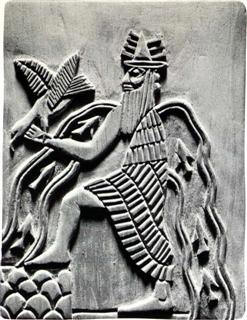 Enkidu letting wisdom stream out over the world
Enkidu letting wisdom stream out over the world
Here we see Enkidu placed as a helper for Gilgamesh, where the Luciferic Enkidu should bring equilibrium with the Ahrimanian Gilgamesh, helping him to purify humanity.
Enkidu represent wisdom.
Gilgamesh and Enkidu
These two are born again and again through history, as the bringer of Wisdom and of Form, as Teacher and Hero, as Aristotle and Alexander, or Aquinas and Christian Rosenkreutz.
In the bible we see them showing the shift from the old clairvoyance to the knew, for example as Esau (red and hairy hunter) and Jacob, or as Solomon and Hiram Abiff [Temple Legend]
The spiritual strength of these two are shown through
These great ‘personalities’ incarnates each hundred years, as Steiner describes in connection with Christian Rosenkreutz and Master Jesus, and it’s naive to believe that these big human beings only have been incarnated the few times as some seems to believe. If you read the Occult History and look for the word ‘personality’ it will point to further incarnations of these persons.
From the Gilgamesh Epic
Steiner tells that this epic describes physical reflections of the spiritual, and that should be considered in the mentioning of Ahriman and Lucifer in the following. I try here to show the two companions relation to the Ahrimanian and Luciferic, to explain their physical roles described in the previous chapter.
Gilgamesh is described as a man with all knowledge, showing him as a highly developed human being, with full control of the physical world, a doer:
The text on the stone states that he is two third god and one third human, king and super human, but he oppresses his people harshly, uses his power egoistically for his own satisfaction.
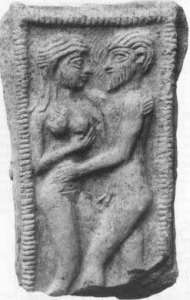 The people call out to the sky-god Anu, the chief god of the city, to help them. In response, Anu creates a wild man, Enkidu, out in the harsh and wild forests surrounding Gilgamesh’s lands. This brute, Enkidu, has the strength of dozens of wild animals; he is to serve as the subhuman rival to the superhuman Gilgamesh.A trapper’s son, while checking on traps in the forest, discovers Enkidu running naked with the wild animals; he rushes to his father with the news. The father advises him to go into the city and take one of the temple harlots, Shamhat, with him to the forest; when she sees Enkidu, she is to offer herself sexually to the wild man. If he submits to her, the trapper says, he will lose his strength and his wildness.
The people call out to the sky-god Anu, the chief god of the city, to help them. In response, Anu creates a wild man, Enkidu, out in the harsh and wild forests surrounding Gilgamesh’s lands. This brute, Enkidu, has the strength of dozens of wild animals; he is to serve as the subhuman rival to the superhuman Gilgamesh.A trapper’s son, while checking on traps in the forest, discovers Enkidu running naked with the wild animals; he rushes to his father with the news. The father advises him to go into the city and take one of the temple harlots, Shamhat, with him to the forest; when she sees Enkidu, she is to offer herself sexually to the wild man. If he submits to her, the trapper says, he will lose his strength and his wildness.
Shamhat meets Enkidu at the watering-hole where all the wild animals gather; she offers herself to him and he submits, instantly losing his strength and wildness, but he gains understanding and knowledge. He laments for his lost state, but the harlot offers to take him into the city where all the joys of civilization shine in their resplendence; she offers to show him Gilgamesh, the only man worthy of Enkidu’s friendship. [3]
Here Enkidu incarnates to be the helper and companion of Gilgamesh. He is shown in his pre-human state running wild with the animals, and how he becomes human through creating karma, through lust for living.
The woman Shamhats power is thinking and forming where Enkidu lived in wisdom. Six dayes and seven nights hints at the seven chakras who are prepared for the life on Earth.
He is like a good now, he have become a sentient being, conscious of his own I. He wants to rule over Gilgamesh, but the courtesan told him that Gilgamesh, the Ego, the mind soul, was stronger than Enkidu, the sentient soul. These two soul-bodies are joined together, and even to this day they fight each other, only the day that they don’t fight each other, are they released.
 Separation of the sexes – Twin Soul Aspects – Dual’s
Separation of the sexes – Twin Soul Aspects – Dual’s
He enters the Earth fully:
Cooked food, bread, and wine all weight the physical body down, binding the etheric body to the physical body.
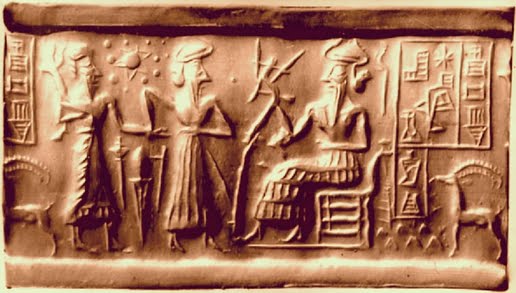 Enki. About 2,500 BCE. Note the image of planets revolving around the Sun!
Enki. About 2,500 BCE. Note the image of planets revolving around the Sun!
The sentient soul were the connection to the spiritual world, and wisdom, at that time. Here we also see the descent into the physical.
Here Enkidu gave tribute to Gilgamesh, representing the mind soul. The next tells about the sacred marriage between the sentient and mind soul, or the etheric and physical body:
The language of Gilgamesh, from his prophetic dreams (“I loved [Enkidu] and embraced [him] as a wife”) to the bridal bed in Uruk — Enkidu’s in retrospect — clearly refers to a “sacred marriage“: the spiritual union or blending of the inner and outer man. None of the extant material names a victor, but the Old Babylonian story given above suggests that the initial strife or “wrestling” is brought to an abrupt end by mutual recognition: Gilgamesh “bent his knees” (to Enkidu’s stature) and “planted his foot in the ground.” Both phrases are apparent wordplays on Enkidu’s name, indicating a successful (or “victorious”) bonding and assimilation. Enkidu’s subsequent acknowledgment and friendly embrace with Gilgamesh confirm their acceptance of the relationship.Up to this point the story has been prologue — an allegory about the evolution and creation both of mankind and of a truly human individual. From here on Gilgamesh and Enkidu go as one, faithful to each other until death. In the Sumerian stories, Enkidu remains the servant of Gilgamesh; in the Babylonian version, Gilgamesh’s mother adopts Enkidu — he becomes not only the servant, companion, and friend of Gilgamesh, but also his younger “brother.” Viewed as a single composite character, Gilgamesh-Enkidu represents the conjoining of heaven and earth, of spirit, soul(s), and body, in a full sevenfold partnership (5) necessary for one to succeed in the hero’s quest. [4]
The one tells that the sentient soul (Enkidu) is below (sevant of) the mind soul (Gilgamish), where he is a younger brother in the other tradition.
With Humbaba the terrible we are in Eden and he is known by Enkidu, which means they are related, and he guards the trees of wisdom and life. Enkidu, representing the Luciferic wisdom, is not ready to fight the Ahrimanic spirits, so he works against Gilgamesh.
This is part of the life of man, going through the twelve signs of the Zodiac:
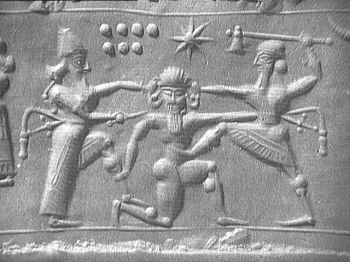 Gilgamesh and Enkidu with Humbaba
Gilgamesh and Enkidu with Humbaba
…
As Gilgamesh and Enkidu approached the forest, their trepidation grew. Shamash sent a message from the sky: “Humbaba has removed six of his seven cloaks. … They saw the height of the Great Cedar. Where Humbaba walked, a path was made. The road was good… [4]
The seven is connected to the chakras, and the seven-terrored was the chakras to clean. The path is the path of Karma.
On the six days travel (and seven nights?) Enkidu interprets the dreams of Gilgamesh, demonstrating that he is closer to the spiritual world. On the entrance to the Cedar Forrest:
Gilgamesh wins over Lucifer/Enkidu and they work together against Ahriman.
Here the Ahrimanic Humbaba tries to split the two, but Enkidu now inspires Gilgamesh with courage. When man has won his fight with Lucifer, he works as helper for man, as a holy spirit.
Here again Enkidu/Lucifer helps Gilgamesh against the Ahrimanic, which on it’s side bans the Luciferic from the physical plane. Enkidu dies, separates man from the spiritual, which introduces death, as man no longer remember his previous lives. The Sentient soul looses it’s sight into the spiritual world, the end of the old clairvoyance.
 Shamash (the Sun) between Mashu’s Twin Peaks,
Shamash (the Sun) between Mashu’s Twin Peaks,
Akkadian, 3rd millennium BC (British Museum)
He now starts his journey on the pure physical plane incarnating through the twelve star signs:
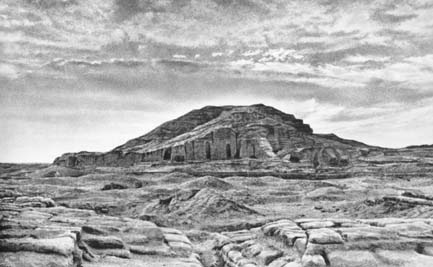 Ziggurat in the Eanna Sector at Uruk (Andre Parrot, Sumer)
Ziggurat in the Eanna Sector at Uruk (Andre Parrot, Sumer)
References
1. Rudolf Steiner: Occult History, Lecture 1;
2. Rudolf Steiner Occult History, Lecture 2;
3. Richard Hooker Mesopotamia Gilgamesh Summary, Washington State University;
4. W. T. S. Thackara The Epic of Gilgamesh: A Spiritual Biography
Full text of Gilgamesh Epic, Gilgameš, Enkidu and the nether world.
- The Temple Legend by Rudolf Steiner
- The Masonic Legend by Max Heindel
- The Hiramic Legend by Manly P. Hall
Use back-button to go back to text!
Map
The Trap of Materialism
Posted by Kim Graae Munch in Computers, Esoterics, Politics, Science on April 20, 2009
The Materialistic society we are living in have some build in dangers, which will draw our society in a direction of less faith or trust in man, giving more inhuman conditions for all, and the problem is that we may see it as inevitable.
Centralization is the problem, both politically, of public institutions, of companies and of capital. The mantra ‘Big is Beautiful’ is wrong, the productivity per employee drops with the increasing size of the organisation, and that’s because the single employee have less space to influence his own work, too bound by rules, and because the large organizations are difficult to manage.
In the following paragraphs I will look at its implications, which will be seen through greater aggressiveness, less social skills, and decreasing possibilities to control our future, less possibility to make decisions both in grand scale and in our own lives, both at home and job.
The Trap works through various mechanisms, as
- Materialism, a purely physical view of the universe,
- Pervasive Politics, proliferation of the political system in daily life,
- Groupings, emphasis on group, race, and ethnicity, us and them,
- Orthodoxy, literal and “simple” interpretation of the Gospels,
- Superstition, esoteric beliefs without foundation in thinking skills,
- Abstract Thinking, cultivating abstract theorization,
- Quantitative Thinking, purely quantitative (statistical) observation.
These combined with a Dualistic world view, where everything is Black and White, will increase the strife between people all over the world.
Dualism sees everything in opposites,
and this is one of the greatest dangers today: If you are not with me, you are against me. That is a widespread sickness, especially on the Internet where you can hide under anonymity, but orthodoxy of any kind: religious, atheistic, or political, moves our future in a dangerous direction. What makes it so dangerous are that both sides believe that they fight on the side of good, but the reality is that they both fight for extremism, truth is always somewhere in between.
The deception is not to see the full picture, to understand both sides in any relation!
The challenge is to find the Golden Mean between the extremes.
The following paragraphs will look into different areas where Dualism endangers our society.
Materialism
Science is seen as the absolute truth against black superstition represented by religion. It’s not seen as different and complementing views on the same reality. It has started the Atheistic religion, attacking spirituality and moral values. Darwin is their prime god, and their Messiah are the Sentient Robots they hope will come and save the world. The problem are that most of the Atheists don’t really understand what they are preaching, and they don’t accept scientific results if it’s against their own beliefs. See Is it possible to make Intelligent Machines?
Science can’t make decisions or take responsibility, as Science in itself have no moral. Science is always used by others, more dynamic groups of society, by players on the market or in politics, whose moral aren’t better than the Courts or the Voters.
“Our scientific power has outrun our spiritual power. We have guided missiles and misguided men.” Martin Luther King Jr.
“I believe that a scientist looking at nonscientific problems is just as dumb as the next guy.” Richard Feynman
“As soon as questions of will or decision or reason or choice of action arise, human science is at a loss.” Noam Chomsky
Pervasive Politics
You see Dualism in politics, especially in two-party systems, where there is no space for other views. Politics dominates today everybody’s life, in contrast to forty years ago, where politics was talked about at the elections every fourth year. The laws gave then rules for the relation between the citizens, today the laws regulate the relation between state and citizens.
The politics invasion of the private sphere destroys the natural equilibrium of the society. The economic system today is an example of this, the equilibrium of that system ends regularly in chaos as the system is made for the speculators, not for the companies, nor for the country and its citizens. Today the decisions are taken by regulations or laws on behalf of groups, where prior the decisions were taken by those who knew about the concrete cases on behalf of persons. Wrong decisions had only small consequences then, where wrong decisions today have far heavier consequences as more people are dependent on these decisions.
This is a problem all over the world, and it gets worse the more laws and rules people have to follow.
One of the biggest lies of today: We need more regulations as a result of the society’s complexity. Wrong, it’s more complex as a result of all those regulations. Computers takes the complexity out of complex tasks, and prefabricated goods takes the complexity out of manual work, so what is complex today, except the laws?
Groupings
There is a tendency to split up in groups, instead of seeing mankind as one; people split up after race, religion, language, land, locality, sex, or whatever. There are lots of hate in this, not least on the Internet.
Orthodoxy
There is a tendency to read religious text’s to narrowly, as Jehovah Witnesses, and other religious groups who take their holy books too literally. Durban Two, where the Islāmic countries tries to prohibit any critic of religion, is a typical example showing that discussions of religious content is unwanted. New religious movements like Scientology, Atheism, the Moonies, and so on, are also too rigid.
Superstition
Another trap is to accept the words of religious, esoteric, and scientific origin without thoughts. Spiritual inclined are in danger of reading spiritual literature without conscious understanding, but that includes also Atheists reading scientific texts without understanding.
Abstract Thinking
in contrast to real understanding. It’s seen everywhere, and is also part of the previous areas. Man is seen as a thing not as a being. The reality is not abstract, and every decision based on abstract thinking is wrong, especially if living beings are involved.
Quantitative Thinking
and Statistics without understanding. Let’s say a politician want to make a law, and it will make 0.123% of all families go bankrupt, but as the percent is low nobody sees it as a problem. Nobody understands that there are real people behind those figures. Quantitative thinking always works through abstractions.
Big Mother
The development moves in a direction where we can expect that our personal ‘I’ is assimilated by the masses, the collective. In the western world we are talking about freedom, that nobody shall tell us what to do, and we are fighting (Duality problem) against conspiracies, against CO2 pollution, against many other things, but we don’t define and work consistently for a world worth living in. At the same time our capabilities to decide our own destiny are diminishing, regulated by law, organizations, computers, and infrastructure. The result may be that everybody just follow the route with least resistance, which are built through directives, regulations, computer capabilities, ending in a situation where nobody thinks or makes decisions any more. And it’s all made for the good of the citizens by the Big Mother.
Political Correctness
Political Correctness is sneaking in everywhere, without any conscious effort by any conspiratorial agency, but because of the path of least resistance.
No Childhood
Many of the restrictions and laws are made because of lacking parenting, children no longer learn to live in a community, they are each and all small kings and princesses, who don’t understand that others don’t see them as such. Their understanding of scientific, historic or creative endeavors is as small as it has ever been. The children learned more at the camp fire than the children of today. As they don’t know how to behave, more and more laws are created to remedy the lacking parenting.
The central problem are that Children aren’t allowed to be children any longer, or as Michael Jackson says:
“Childhood has become the great casualty of modern-day living. All around us we are producing scores of kids who have not had the joy, who have not been accorded the right, who have not been allowed the freedom, or knowing what it’s like to be a kid.
Today children are constantly encouraged to grow up faster, as if this period known as childhood is a burdensome stage, to be endured and ushered through, as swiftly as possible.”
…
“Love, ladies and gentlemen, is the human family’s most precious legacy, its richest bequest, its golden inheritance. And it is a treasure that is handed down from one generation to another. Previous ages may not have had the wealth we enjoy. Their houses may have lacked electricity, and they squeezed their many kids into small homes without central heating. But those homes had no darkness, nor were they cold. They were lit bright with the glow of love and they were warmed snugly by the very heat of the human heart. Parents, undistracted by the lust for luxury and status, accorded their children primacy in their lives.” Michael Jackson, Speech at Oxford University(2001)
Complicated Structures
You can’t make tax-systems as complicated as they are today without computers, and you can’t control the many citizens or employees, as we can today, without computers; the amount of data are enormous. They make it possible to create structures which are difficult to manage without using computers, and computers don’t know HR.
GM and the American Automobile Industry are good examples of these gigantic Companies, who would be impossible to manage without stiff administrative structures and computers, and it’s extremely difficult to change these structures if needed. But modern software organizations have the same problems, with their software base, as Microsoft with their operating system, and their Office System, Yahoo with it’s big software base and reductions in labor have their problems, and new organizations as Google with it’s extreme growth will quickly get into the same problems, the only way out are to regularly rebuild old systems from the ground without any application reuse, and keeping different applications separated on application level, and using methods who makes the programming as simple and cost effective as possible.
These big organizations are extremely susceptible to the Peters Principle:
I believe computers can be a boon to mankind, but we have to control how and what they are used for, not letting their possibilities decide our future, as their strength can be used both for the good and the bad.
Management and Computers
You can use computers to many things, they can plan routes for transport to decrease energy consumption, and many other useful things. This sounds good, but if we don’t take care, it could mean that it makes the knowledge and experience of man superfluous or even dangerous; man’s role degraded to a machine.
The need for knowledge is diminishing everywhere in the society, except within the computer world. Many jobs who needed educated Craftsmen can now be done by unskilled labor, as building materials don’t need special skills any more, and the computer has taken over a lot of paper work and decision-making. This makes everybody to secretaries except the secretaries, even executives writes their own letters and calculating sheets on their computers, instead of using secretaries, so they could do what they were hired and paid for: Manage.
The term “Human Resources” is in itself a degradation, people are not individuals any longer, they are a kind of commodity. See “Human Resources” by Scott Noble.
Large Structures
The physicist Geoffrey B. West studies large structures like cities and corporate organisations, and has found that cities increases it’s productivity and also it’s problems, while corporate organisations decreases their productivity as they grow.
Public organisations have of course the same problems as the corporate companies, they don’t trust their employees.
Cities are good examples on how the unstructured principles works, how the size of the city increases the production per citizen.
No Competent Leaders
What makes it so frustratingly absurd is that we are giving our independence to a system, a network of directives and conventions, without any persons being in charge. There is nowhere you can go saying that it’s wrong and it should be otherwise, everybody will tell you, that’s how it is and it has always been that way, and it can’t be in any other way, as it’s too costly to change the computers programming just because of you! Of cause, we have leaders in the top of the state or the corporate companies, but as the decision-making are moved up through the hierarchy (following automatic rules,) it becomes more and more difficult to manage the big organizations, as everything becomes dependent on one decision maker alone, and few know how to or can change the course. It’s more difficult to change the direction of a State, Organization, or a Company than a Super Tanker. The organizations becomes automatons, and the companies go down in case of unanticipated events which craves structural changes.
GM and the American Automobile Industry are good examples of this inability to change, they had known for decades that they should change their models to compete with Japanese and European manufacturers, but they couldn’t.
The incompetence of these organizations will give rise to Conspiracy Theories as Hanlon’s Law warns about:
Automated Decisions
Buying and selling on the stock market are for a great part based on automated decisions on computers, but as we have seen, it can go terrible wrong when some unanticipated events shows up. What’s worse, the stock market was made to foster strong and sound companies, not for computer controlled gaming, but for intelligent investment.
As fewer and fewer managers can make decisions, these decisions will be automated as rules in computers, and it will be impossible to make decisions based on individual concerns.
Decreasing Social Intercourse
Computers are exceptional for entertainment, you can live your life on the Internet, without any direct social contact. You can play games, make your work through the net if necessary, discuss, hunt sex/ books/ programs/ random data on the net (can be like drugs,) book your food from a local pizzeria, book escort girls, men, and boys, eventually finding mates on the net if you really want to live together with another being:). The film Matrix is a plausible destiny, not by force, but semi freely. It’s not Big Brother, it’s Big Mama.
Less Social Skills
In the old days, children, teenagers, and adults learned by living in a community, and there was room for everybody, also the village idiot. These and other unusual persons were educated by their surrounding who were mostly normal. We are today living more and more on the Internet, learning our social skills through social applications and computer games, the old community’s influence are replaced by the influence of the Internet comrades, and as like seeks likes, they can only increase their phobias or other disorders. Examples are numerous: pedophilia, school killings, terrorists, all kind of surrealistic interests, and so forth. The Law of Sayre’s are relevant in many of these cases:
No Privacy
Children and teenagers can be reached by mobile and GPS always and everywhere, followed on the Internet through Twitter or Facebook by their parents. No privacy. The same goes for the adults, no privacy, open for state officials, economic institutions, and employers. Password protection, pseudonyms, and like precautions is no hindrance, Cyber-Investigators will find everything, relevant or not. You can not even go to the North Pole or to Himalaya in peace, they can always reach you, and you them.
Where’s the remotest place on Earth?
In our hyper-connected world, getting away from it all is easier said than done. New Scientist.
Conspiracy Theories
The frustration has to go somewhere, and while there are no one responsible for our situation, and no one with enough insight, determination, and power to change the situation, we invent some god-like powerful conspirators who in all secrecy, with hundreds of employees, stands behind all the bad in this world. The truth is, that most leaders are so incompetent that it hurts. Just look at Iraq. The military invasion was well thought out, but the rest was incompetence par excellence. And that is not an exception, it’s the rule. Of cause there are conspiracies and secret operations, but if more than one participant knowing about the conspiracy are alive a year later, it’s just a question of time before the world know. Another reason to use few people are that really competent people are difficult to find, and the more people involved the bigger the risks for failure, and the bigger the consequences of a failure, the less interesting the project becomes. The best way to check if a conspiracy theory is viable or not, isn’t the technical evidence but the psychology and the necessary resources behind, how big is the risk, who gains, what’s their gain, how many participate, and what expertise are necessary.
A sober view on Conspiracy Theories from the left:
Noam Chomsky on Conspiracy Theories
In case the video is not functioning look here
What’s the mechanism behind the development?
![]()
Literature
Thomas Piketty
The Independent: The French economist forcing America to wake up to the end of The Dream.
Out of America: Thomas Piketty’s tome which skewers the idea that anyone who works hard can make it in the US seems to have hit a nerve
“Capital In The Twenty-First Century”, all 685 pages of it, is the No 1 best-seller on Amazon – apparently the first time that anything published by the venerable Harvard University Press has attained such dizzying celebrity. No self-regarding dinner party in Washington or New York is worth its salt without a discussion of it. Last Friday, came the ultimate accolade of a multiple coronation on the op-ed page of The New York Times.
The Huffington Post: Economist Thomas Piketty Explains Why Income Inequality Is Just Getting Started
Michael Lewis
Wired: Michael Lewis on Exposing Wall Street’s Biggest High-Tech Swindle in the book: Flash Boys: A Wall Street Revolt
Flash Boys explores the world of high-frequency trading, a scheme in which traders use ultra-fast network connections to sniff out the intentions of other, slower traders, thereby acting before others can respond. Critics of the practice–Lewis chief among them–argue that high-frequency trading creates something akin to insider trading: a predatory environment for less advantaged investors. WIRED spoke with Lewis at an event organized by Live Talks in downtown Los Angeles.
Elizabeth Warren
A Fighting Chance (Apple, Amazon)
An unlikely political star tells the inspiring story of the two-decade journey that taught her how Washington really works—and really doesn’t.
In this passionate, funny, rabble-rousing book, Warren shows why she has chosen to fight tooth and nail for the middle class—and why she has become a hero to all those who believe that America’s government can and must do better for working families.
New York Times: Book review of A Fighting Chance
A good review, also giving a good idea about who she is.
Allan Bloom
The Closing of the American Mind, Simon & Schuster Inc.
Christopher Lasch
Haven in a Heartless World, 1977, Basic Books, Inc.
In the American political vocabulary, “family” and “family values” no longer simply evoke pictures of harmonious scenes; they also push our buttons (left and right) about what is wrong with society. One of the earliest and sharpest cultural commentators to investigate the twentieth-century American family, Christopher Lasch argues in this book that as social science “experts” intrude more and more into our lives, the family’s vital role as the moral and social cornerstone of society disintegrates – and, left unchecked, so does our political and personal freedom. Haven in a Heartless World is a trenchant analysis of the plight of the family. Lasch takes a clear-eyed look at the institution in which America’s future generations are being raised and finds it faltering.
Geoffrey B. West
A Physicist Turns the City Into an Equation:
A New York Times article on his work.
Growth, innovation, scaling, and the pace of life in cities:
Describes the mathematical background for his work.
Atticannie’s Blog
Why Teacher Drink, the sequel: Natalie Munroe speaks out
Antoine de Saint-Exupery
have written a little book called “Night Flight” which describes man’s fight against the Materialistic docility to keep man competent and responsible.
By Rudolf Steiner
Inkarnation Ahrimans in German/Deutch and in English.
The the Bafta-winning film-maker Adam Curtis:
Political Correctness
Political Correctness is sneaking in everywhere, without any conscious effort by any conspiratorial agency, but because of the path of least resistance.
The smart way to keep people passive and obedient is to strictly limit the spectrum of acceptable opinion, but allow very lively debate within that spectrum – even encourage the more critical and dissident views. That gives people the sense that there’s free thinking going on, while all the time the presuppositions of the system are being reinforced by the limits put on the range of the debate.
Noam Chomsky
 The primary thing is to build a consistent framework around ones knowledge, extending it when new knowledge comes to. Don’t make the structure bigger than you can hold it consistent, that is, if too many loose ends are floating around it’s too difficult to handle. I started with the Akasha Chronicles by Steiner, which is the Rosicrucian Cosmic History. More in
The primary thing is to build a consistent framework around ones knowledge, extending it when new knowledge comes to. Don’t make the structure bigger than you can hold it consistent, that is, if too many loose ends are floating around it’s too difficult to handle. I started with the Akasha Chronicles by Steiner, which is the Rosicrucian Cosmic History. More in  Never rely on one source. Whatever you find it should be consistent with other sources and/or it’s inherent logic should be impeccable. Findings without supporting evidence or inconsistencies should be saved until further evidence for or against is found. As a teenager I was somewhat fascinated with UFOs but then decided to have no meaning about them as it lacked both hard evidence, logical support, and relevance for my life.
Never rely on one source. Whatever you find it should be consistent with other sources and/or it’s inherent logic should be impeccable. Findings without supporting evidence or inconsistencies should be saved until further evidence for or against is found. As a teenager I was somewhat fascinated with UFOs but then decided to have no meaning about them as it lacked both hard evidence, logical support, and relevance for my life.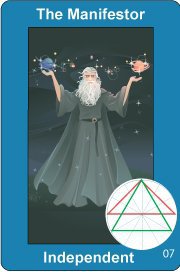




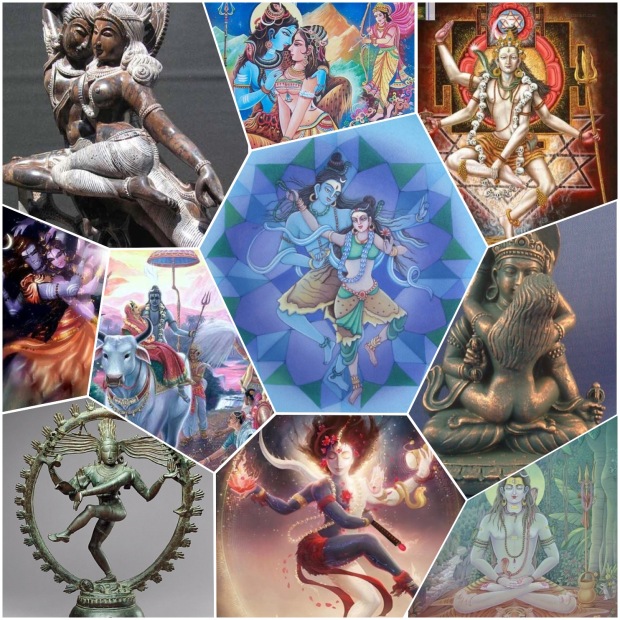







![kimgraaemunch [] GMail () com](https://kimgraaemunch.files.wordpress.com/2017/02/kimgraaemunch-g.png?w=210)












